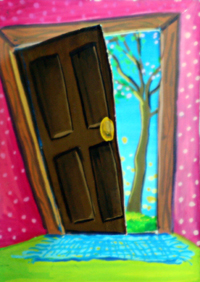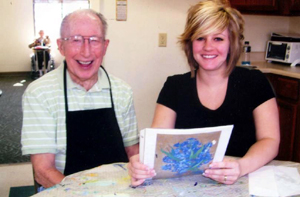News from the Wassenberg Art Center
New dual exhibit to open
By Hope Wallace
This Sunday marks the opening of our new dual exhibit “It’s in the Cards & The Art of Therapy”. In the Cards showcases an unusual art form where artists create original works of art on 2.5 x 3.5 inch cards roughly the size of

baseball cards, called “artist trading cards.” Artist Trading Cards (ATCs) originally developed in Switzerland by M. Vänçi Stirnemann around 1997 spawned a worldwide trading culture. They can be created from almost any medium from paint, pencil, to cloth and metal. The idea behind the cards are not to sell the works but to trade with other artists, meet face to face and expand and exchange techniques and ideas. Anyone can and is encouraged to create these small works of art as a good way to refine their style, medium or technique but most importantly to meet other artists and have fun.
While researching ATCs, and being prone to distraction when presented with new ways of making stuff, I decided to try one! I like painting and sculpting windows and doors, and so painted a small door with gouache (similar to tempera paint). Doors open, so why shouldn’t this one? Doors open for the primary reason of walking through them!
Art is therapy in many instances but sometimes it’s much more. In our exhibit “The Art of Therapy”, we will be featuring artists from Vancrest Nursing Home, Bittersweet, Inc. in Whitehouse, Ohio and several other individuals both local and out-of-state with varying degrees of physical and/or developmental disability. However, in this instance “ability” is the focus.
The artists of Vancrest, directed by Lydia McKinley, (CMT) will be displaying approximately 30 works in tempera using an unusual technique called MnemeTherapy™ that is both textural and fluid. MnemeTherapy™ uses everyday pleasures such as singing, movement, painting and story telling in a unique combination to stimulate dramatic changes in the brain.
Persons with Alzheimer’s, Huntington’s disease, Parkinson’s, stroke victims,

Autism and Asperger’s syndrome PDD, ADD, ADHD Down Syndrome and Cerebral Palsy have benefited successfully with this therapy. Unlike Art Therapy, MnemeTherapy™ focuses on brain synchronization and sustained attentive focus, which can create new neural pathways. The show will also include photography from Van Wert’s Will Hawkins, work by local artist Val Sluterbeck, and drawings from Virginia artist Bruce Lynn Dellinger. In addition, artists from Bittersweet, Inc., an 80-acre farm community serving adults with autism, will be exhibiting works in acrylic, gouache and ceramics. These artists also have a small display at The Niswonger Performing Art Center in the upper lobby.
We invite you to visit and enjoy this exhibit with an opening reception this Sunday, April 3, 1-5 p.m. and continuing through May 7. This show is graciously sponsored by Vancrest Nursing Home, Van Wert. Wassenberg Art Center exhibit hours are Tuesday-Sunday, 1-5 p.m. Admission is free.
The Wassenberg Art Center is located at 643 S. Washington Street in Van Wert. Contact us at 419.238.6837 or wassenberg@embarqmail.com. Information about current classes and exhibits is on the calendar at our website, www.vanwert.com/wassenberg.
Monhegan; a beacon for artists
By Kay Sluterbeck
Monhegan, a rough, rock-armored forested island rising out of the sea ten miles or so off the coast of Maine, is only a mile wide and two miles long. The first recorded Anglican service in the New World took place on Monhegan in 1608, and the island was an important early stepping stone for the European colonization of America. It became a safe haven for explorers and fishermen — and artists.
It started in 1858, when Monhegan residents looked up from their work to watch the U.S. Schooner “Vigilant” drop anchor in the harbor. Two young men came ashore. Some thought they were government inspectors, but instead of going up Lighthouse Hill to inspect the lighthouse the men set off across the island, carrying sketchbooks. Their names are listed as Aaron Draper Shattuck and Mr. Brown, and they were the first artists to visit the island. They were on a sketching expedition and had persuaded Captain Bilby, master of the Vigilant, to let them go along on the schooner’s inspection trip of the Maine coast.
Knowing they had to be ready to rejoin the captain when he finished his inspection of the lighthouse, they quickly left the village to find the cliffs they had seen from the schooner. The artists managed to get a few hasty sketches before they returned to the Vigilant. The visit to the island left an indelible impression on Shattuck. He was excited by the scenery — the beautiful coves, and the huge cliffs that rose out of the sea. The constant dashing of the surf on the rocky shore fascinated him. He told his friends.
Artists began to visit the island. Soon an increasing number of painters were making the sometimes-rough voyage to the island, where friendly island families took them in. One artist even found lodging in the lighthouse keeper’s cottage. Finally one of the island ladies, Sarah Albee, realized there was a need for a boarding house to put up the visitors and their painting supplies. Tourists also began to visit the island, so her boarding house quickly turned a profit. She was so successful that she opened the island’s first hotel, the Albee House, now the Monhegan House.
Eventually a number of artists decided to make Monhegan Island their summer home. In the early 1900s studios and summer cottages started to appear alongside the weathered homes of the island residents.
Although tourism has made its mark, the island still looks much as it did when Shattuck made his hasty sketches of the cliffs. The light and the interaction of land and sea continue to lure artists from around the world — from Hawaii, Russia, Germany, Italy, and from all over the United States. They come to work in a wide range of styles, using all sorts of mediums including lithographs, etchings, woodcuts, watercolors, oil paintings, and drawings. It’s no surprise that Monhegan is sometimes called “The Artists’ Island.”
The spell Monhegan casts on artists can be overwhelming. Robert Henri, head of New York’s “Ashcan School” and an influential art teacher, visited the island in 1903 and his letter home to his family is almost incoherent: “Great rocks — cant describe it — looks like foreign and don’t — looks like Monhegan…Its all there and builds down to the sea and surf in a mighty way.”
Fifty years later Reuben Tam came to Monhegan from his native Hawaii. “I like places where the forces of nature are in active operation,” he wrote, “Monhegan Island, Maine — the drowned coast, the region of fog, grandeur and intimacy, the edge of land and the sea.”
Jamie Wyeth, who seasonally lives on Monhegan in a house built by artist Rockwell Kent, said, “I could stay right on this point … and spend the rest of my life painting.”
POSTED: 03/30/11 at 1:51 pm. FILED UNDER: What's Up at Wassenberg?







